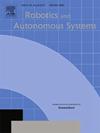Cooperative Formation Control Strategy for Multi-robot System Based on APF Algorithm and Sliding Mode Estimator
IF 5.2
2区 计算机科学
Q1 AUTOMATION & CONTROL SYSTEMS
引用次数: 0
Abstract
In this paper, a cooperative formation control strategy for the multi-robot system based on sliding mode estimator and Artificial Potential Field (APF) algorithm is proposed to solve the problem of formation maintenance, trajectory tracking and collision avoidance in a multi-obstacle environment. The desired information of the formation robots is given by a virtual leader, and the state information of the virtual leader can only be obtained by some of the follower robots. Firstly, based on the consensus algorithm, a finite time distributed sliding mode estimator is designed for each follower robots to obtain the desired information. Secondly, based on the error information of the follower robots, a distributed Model Predictive Control (MPC) formation controller is designed to address the issues of forming and maintaining a desired formation while tracking an desired trajectory. Then, an obstacle avoidance function of the multi-robot formation for obstacle avoidance and collision avoidance is constructed based on the APF algorithm, and a Lyapunov function is designed for stability analysis. The estimator and controller are combined to form a formation cooperative control strategy, which together ensure the formation structural performance and safety stability of the multi-robot system. Finally, simulation experiments are conducted to verify the effectiveness and robustness of the proposed cooperative control strategy by combining typical roads and actual obstacle scenarios in an intelligent factory environment.
基于APF算法和滑模估计的多机器人系统协同编队控制策略
针对多障碍物环境下的编队维护、轨迹跟踪和避碰问题,提出了一种基于滑模估计器和人工势场(APF)算法的多机器人协同编队控制策略。编队机器人的期望信息由虚拟领导者给出,而虚拟领导者的状态信息只能由部分跟随机器人获得。首先,在一致性算法的基础上,为每个跟随机器人设计了有限时间分布滑模估计器,以获得所需的信息;其次,基于跟随机器人的误差信息,设计了分布式模型预测控制(MPC)队列控制器,解决了在跟踪期望轨迹的同时形成和保持期望队列的问题;然后,基于APF算法构造了多机器人编队避障避碰的避障函数,设计了Lyapunov函数进行稳定性分析。将估计器与控制器相结合,形成编队协同控制策略,共同保证了多机器人系统的编队结构性能和安全稳定性。最后,结合智能工厂环境中的典型道路和实际障碍物场景,进行仿真实验,验证了所提协同控制策略的有效性和鲁棒性。
本文章由计算机程序翻译,如有差异,请以英文原文为准。
求助全文
约1分钟内获得全文
求助全文
来源期刊

Robotics and Autonomous Systems
工程技术-机器人学
CiteScore
9.00
自引率
7.00%
发文量
164
审稿时长
4.5 months
期刊介绍:
Robotics and Autonomous Systems will carry articles describing fundamental developments in the field of robotics, with special emphasis on autonomous systems. An important goal of this journal is to extend the state of the art in both symbolic and sensory based robot control and learning in the context of autonomous systems.
Robotics and Autonomous Systems will carry articles on the theoretical, computational and experimental aspects of autonomous systems, or modules of such systems.
 求助内容:
求助内容: 应助结果提醒方式:
应助结果提醒方式:


